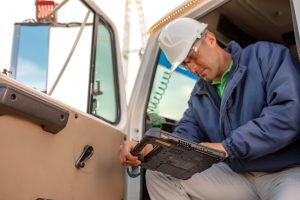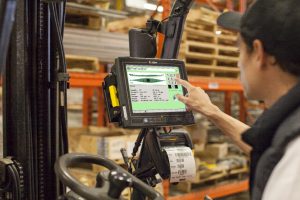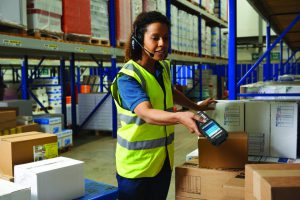Enterprise mobility, enterprise mobility management and enterprise mobility solutions – what do these words mean to you? For supply chain employees, regardless of their title and responsibilities, these words may not resonate. What would hit home however, would be a question to 5 year+ industry veterans on how much things have changed in the warehouse, transportation and logistics space, as innovations and technology integrations have grown to fit into much of their workday.
 By definition, enterprise mobility is the general integration of mobile devices, business applications and the Internet of Things (IoT) into work processes, to bring them into the digital world for the sake of improving workplace productivity. The end result is more tasks and responsibilities become available from anywhere, often with rapid speed, while communication and collaboration becomes a more free-flowing process. If a logistics supervisor, shipping manager, warehouse operator or supply chain director was given this explanation, they could easily draw conclusions as to how it applies to their workplace.
By definition, enterprise mobility is the general integration of mobile devices, business applications and the Internet of Things (IoT) into work processes, to bring them into the digital world for the sake of improving workplace productivity. The end result is more tasks and responsibilities become available from anywhere, often with rapid speed, while communication and collaboration becomes a more free-flowing process. If a logistics supervisor, shipping manager, warehouse operator or supply chain director was given this explanation, they could easily draw conclusions as to how it applies to their workplace.
- “We use handheld mobile computers and tablets in combination with our new WMS (warehouse management system) and mobile printers to be able to run most operations on the go.”
- “Paperwork and segmented systems have been replaced with rugged handheld computers and workforce software we can reach via the web. Our shipping, receiving and picking errors have all been reduced now that we are connected to our e-commerce system from our warehouse floor and beyond.”
- “Our drivers now dock and carry off their trucks company-issued handheld devices and tablets to their vehicles, in order to access databases and reporting functions we require them to utilize in the field. Cell phones used to be our only form of communication, along with offline forms we would manually enter into our systems later. Signature captures are no longer the only thing we gather in real-time.”
- “There’s hundreds to thousands of rugged mobile devices in our pool; luckily for us, our MDM (mobile device management) platform lets our IT and management teams, monitor, maintain and control their every use from anywhere. We even know their physical condition!”
- “Automation is where our work site is headed, but not without people driving it. RFID and RTLS (real time location systems) helps us do more with less, by tracking and tracing people, products, assets and day-to-day analytics without having to stop and think about it.”
Simply put, enterprise mobility has taken over the docks, plant floors, office spaces and the future process improvement strategies being drawn up today by supply chain managers and the C-suite. Sensors, beacons, stationary cameras, printers and scanning hardware, among so many more technologies you’ll find now are linked into the IoT revolution, away from the screens and systems in the hands of the modern worker. The numbers are supporting what is seen as the rapid rise in IoT-anything, with more than 64 billion IoT devices available by 2025, up from about 10 billion in 2018, and 9 billion in 2017, according to Business Insider.

Cisco experts claim that every second, 127 devices are newly added to the Internet. The rollout of WiFi 6, or the next generation of networking couldn’t have come at a better time. WiFi 6 promises to greatly enhance the capacity potential of wireless networks, enabling them to handle more devices than ever was considered possible, without any decline in speed. Thus, the “backbone” is in place to support what enterprise mobility is today, well into the future, making it easier to scale and expand IoT capabilities within all of the physical properties along the supply chain. On the logistics side, the release of 5G takes the baton where WiFi 6 falls back. Where WiFi 6 enhances capacity and stability of speeds regardless of the number of devices connected, 5G is a step up in the overall speeds and the reliability of connections to IoT devices. 5G’s overall worth to businesses and consumers alike will be dependent on the wireless carrier, being the gatekeepers of course.
But what is the real takeaway to having everything connected within the supply chain, via strategies to make enterprise mobility a key component to production? Meaning, we all like nice things, but how do enterprise mobility tools, IoT and new network advancements change the way we work?
Enterprise Mobility = Better Shift Productivity & Efficiency
 As mentioned previously, doing more with less is at the cornerstone of reasons why more enterprise mobility and IoT integration adoptions are happening at rapid rates. There’s often a number of redundancies and laborious tasks that amount to little gain, across any position in the supply chain, where the right combination of hardware, software, and in some cases support services like managed services can eliminate them. For the warehouse worker to the employees out in the field, enterprise mobility solutions can yield more time back to focus on more significant jobs. For mid-management, up the organizational chain, “the big picture” can become more of the focus and the analytics supplied on the back end from data collection tools assist in better critical decision making in real-time.
As mentioned previously, doing more with less is at the cornerstone of reasons why more enterprise mobility and IoT integration adoptions are happening at rapid rates. There’s often a number of redundancies and laborious tasks that amount to little gain, across any position in the supply chain, where the right combination of hardware, software, and in some cases support services like managed services can eliminate them. For the warehouse worker to the employees out in the field, enterprise mobility solutions can yield more time back to focus on more significant jobs. For mid-management, up the organizational chain, “the big picture” can become more of the focus and the analytics supplied on the back end from data collection tools assist in better critical decision making in real-time.
Enterprise Mobility = Improved Response Rates
Customer service is more than what meets the eye in the retail space and through the user experience of a company website. The path to satisfying patrons starts in the warehouse and within the logistics that ensure goods make their final destination. Delays, errors and/or a lack of communication can be the difference between residual business or not, let alone whether or not a current order is voided. Trust is important, as we all know as consumers ourselves. With a more interconnected network of on-site employees, databases/applications, services teams and the products themselves, the customer’s turnaround time for orders, requests and/or services is ultimately faster than was considered acceptable in the past. Often, access and visibility of the process is made available as well – a feature many customers appreciate.
Enterprise Mobility = Greater Visibility Of Operations In Real-Time
 Sure, customer visibility of the path their goods take is great, but it means nothing if the provider themselves are unable to control inventory and keep tabs on the entire shipping and receiving process themselves, to make sure what they see isn’t a broken system. Smart warehouses and transportation logistics today are the result of more than just applying new-age tech; the continuous improvements made by all employees that make an impact down the supply chain are what matters. Warehouse management systems, for one thing can spotlight inefficiencies before they become business killers. The info is there, but diagnosing what’s next comes internally. Complementing these with the right mobile handheld computer or tablet brings to the fold a better way of handling the workday’s demands, regardless of job title, roles or responsibilities if applied correctly (and often with the right workforce software to complement). The freedom of movement these extend, plus the empowerment to have an array of job tasks and information at the palm of your hand, strips away the obstacles that placed a ceiling on the amount of productivity that could be had on any given day.
Sure, customer visibility of the path their goods take is great, but it means nothing if the provider themselves are unable to control inventory and keep tabs on the entire shipping and receiving process themselves, to make sure what they see isn’t a broken system. Smart warehouses and transportation logistics today are the result of more than just applying new-age tech; the continuous improvements made by all employees that make an impact down the supply chain are what matters. Warehouse management systems, for one thing can spotlight inefficiencies before they become business killers. The info is there, but diagnosing what’s next comes internally. Complementing these with the right mobile handheld computer or tablet brings to the fold a better way of handling the workday’s demands, regardless of job title, roles or responsibilities if applied correctly (and often with the right workforce software to complement). The freedom of movement these extend, plus the empowerment to have an array of job tasks and information at the palm of your hand, strips away the obstacles that placed a ceiling on the amount of productivity that could be had on any given day.
Enterprise Mobility = Cost Control
More than just the trimming of labor costs, enterprise mobility and IoT together generally will grow revenues by virtue of removing inefficiencies that exist in multiple, if not all departments. Full-fledged enterprise mobility solutions – hardware, software and services – can squash reoccurring problems that drag on the bottom line and bridge gaps that arise from archaic communication and collaboration methods in place for supply chain teams. No one likes to single out substandard work performance, but when it does occur, a more connected organization through enterprise mobility and IoT makes supervision of the workforce easier. Further, pinpointing the cause of costly mistakes, such as raw material/product waste, damages and machinery failures is important to catch before too long. As cliche as it is, time IS money. Even when everything is going right, having accurate, digestible data on the day-to-day inner-workings of the supply chain at large upon request, can only benefit superb leaders who know how to turn it into action (and dollars).
The total economic impact of IoT could be close to $15 trillion dollars by 2025. It isn’t hard to see, if you’re an organization that is curious about how to be a “smart business” through the ways of enterprise mobility, that your competition is either already engaged in the tough conversations to come, or have already put pen to paper. The time is now to act.
